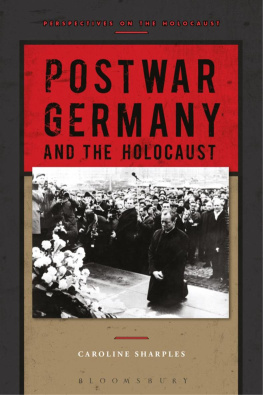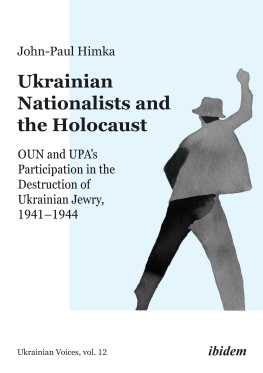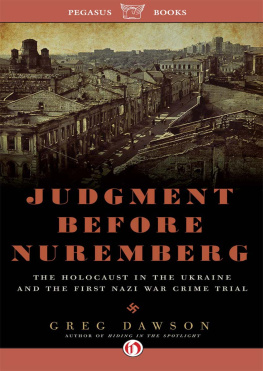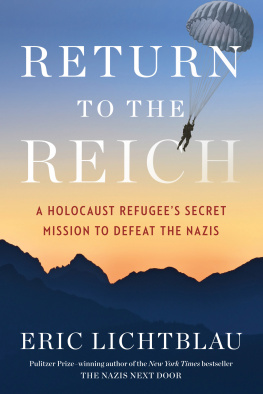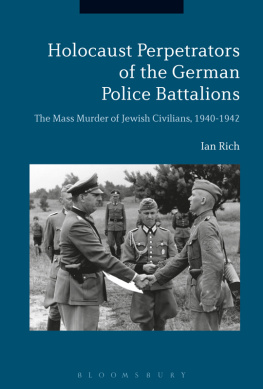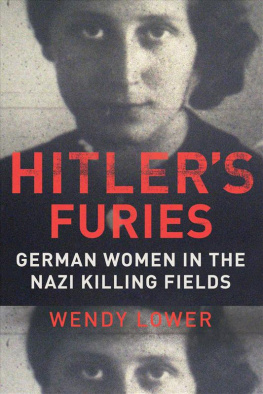Lower - Nazi Empire-Building and the Holocaust in Ukraine
Here you can read online Lower - Nazi Empire-Building and the Holocaust in Ukraine full text of the book (entire story) in english for free. Download pdf and epub, get meaning, cover and reviews about this ebook. City: Chapel Hill;N.C;Germany;Ukraine;Z︠H︡ytomyrsʹka oblastʹ, year: 2007;2005, publisher: The University of North Carolina Press, genre: Politics. Description of the work, (preface) as well as reviews are available. Best literature library LitArk.com created for fans of good reading and offers a wide selection of genres:
Romance novel
Science fiction
Adventure
Detective
Science
History
Home and family
Prose
Art
Politics
Computer
Non-fiction
Religion
Business
Children
Humor
Choose a favorite category and find really read worthwhile books. Enjoy immersion in the world of imagination, feel the emotions of the characters or learn something new for yourself, make an fascinating discovery.

Nazi Empire-Building and the Holocaust in Ukraine: summary, description and annotation
We offer to read an annotation, description, summary or preface (depends on what the author of the book "Nazi Empire-Building and the Holocaust in Ukraine" wrote himself). If you haven't found the necessary information about the book — write in the comments, we will try to find it.
Lower: author's other books
Who wrote Nazi Empire-Building and the Holocaust in Ukraine? Find out the surname, the name of the author of the book and a list of all author's works by series.
Nazi Empire-Building and the Holocaust in Ukraine — read online for free the complete book (whole text) full work
Below is the text of the book, divided by pages. System saving the place of the last page read, allows you to conveniently read the book "Nazi Empire-Building and the Holocaust in Ukraine" online for free, without having to search again every time where you left off. Put a bookmark, and you can go to the page where you finished reading at any time.
Font size:
Interval:
Bookmark:
Nazi Empire-Building and the Holocaust in Ukraine
2005
The University of North Carolina Press
All rights reserved
Published in association with the United States Holocaust Memorial Museum. The assertions, arguments, and conclusions contained herein are those of the author. They do not necessarily reflect the opinions of the United States Holocaust Memorial Museum.
Set in Gill and Quadraat types by Tseng Information Systems, Inc.
Manufactured in the United States of America
The paper in this book meets the guidelines for permanence and durability of the Committee on Production Guidelines for Book Longevity of the Council on Library Resources.
Portions of the text have been previously published: Wendy Lower, A New Ordering of Space and Race: Nazi Colonial Dreams in Zhytomyr, Ukraine, 19411944, German Studies Review 25, no. 2 (2002): 22854; used by permission of German Studies Review. Wendy Lower, Anticipatory Obedience and the Nazi Implementation of the Holocaust in the Ukraine: A Case Study of Central and Peripheral Forces in the Generalbezirk Zhytomyr, 19411944, Holocaust and Genocide Studies 16, no. 1 (2002): 122; used by permission of Oxford University Press.
Library of Congress Cataloging-in-Publication Data
Lower, Wendy.
Nazi empire-building and the Holocaust in Ukraine / Wendy Lower.
p. cm.
Published in association with the United States Holocaust Memorial Museum.
Includes bibliographical references and index.
ISBN 0-8078-2960-9 (alk. paper)
1. UkraineZHytomyrska oblastHistoryGerman occupation, 19411944. 2. GermanyPolitics and government19331945. 3. Holocaust, Jewish (19391945)UkraineZHytomyrska oblast. 4. World War, 19391945 UkraineZHytomyrska oblast. 5. GermanyColoniesUkraine ZHytomyrska oblastHistory20th century. I. Title.
DK508.833.L69 2005
940.534778dc22 2005001620
09 08 07 06 05 5 4 3 2 1
For the mothers and daughters of the Czilug family: Gitia Malik (born in Liubar, 1909), Rakhilia Stepanskii (born in Liubar, 1901; killed at Babi Yar, 29 September 1941), Liuba Stepanskii (born in Sarapul, 1926; killed at Babi Yar, 29 September 1941), and Klavdia Malik (born in Novohrad-Volynskyi, 1937)
Himmler speaking with Felix Steiner
Hitler visiting with German Red Cross nurses in Berdychiv
German Flyer: Passes for Red Army deserters
German road signs in the center of Zhytomyr
Soviet POWs in a Vinnytsia POW camp
SD officers prepare to hang Moishe Kogan and Wolf Kieper
Rounded-up Jews at the hanging of Moishe Kogan and Wolf Kieper
Organizational chart of the Reichskommissariat Ukraine
Organizational chart of a Gebietskommissariat in Ukraine
Kurt Klemm
Ukrainian forced laborers examined by a Wehrmacht doctor
Ukrainian forced laborers say good-bye to loved ones
Announcement forbidding the sheltering of Jews
Work on the Main Road, by Arnold Daghani
Back Home from Work, by Arnold Daghani
Mass Graves, by Arnold Daghani
German SS-policeman shooting a Jewish man in Vinnytsia
Hitler with Wilhelm List and Hermann Gring
Hitlers office at Werwolf
Himmler receiving birthday congratulations
Himmler inspecting cotton fields in Ukraine
Vinnitsa
German soldiers during the reconquest of Zhytomyr
Nazi-Dominated Europe in 1942 and Plans for a Greater Germanic Empire
The Reich Commissariat Ukraine, 1 May 1942
Administrative Map of the General District of Zhytomyr
Ethnic German Settlement Area, named Hegewald (preservation forest)
The Collapse of the Nazi Empire: The Forced Evacuation of Volksdeutsche from Ukraine, 1943
Little did I know when I started the research for this book that my interest in Ukraine and Holocaust history would end up demanding so much time and energy from family, friends, mentors, and colleagues in Ukraine, Germany, and the United States. Many people who helped me trusted that I would do justice to the material that they generously shared with me. I am responsible for any flaws in the book, but I cannot take full credit for its merits. During my research trips to Zhytomyr, Ukraine, I stayed with the Starovoitov family, without whom I could not have completed this study. I am forever grateful to Klavdia (Malik) Starovoitov, my host mother. She introduced me to Zhytomyrs Holocaust survivor community; she helped me translate handwritten sources in Russian and Ukrainian; and she opened up her home and dacha to me. She and her son Felix negotiated on my behalf with the local archives; as a Westerner with admittedly little sense of how to work the Soviet system of blat (personal favors, barter) and the like, I would have certainly been denied research opportunities without their involvement and know-how.
At the Zhytomyr State Archives, Tatiana Nikolaevna Franz and Hrihorii Denisenko answered my many inquiries about the holdings, brought new material to my attention, and helped arrange interviews with former partisans and forced laborers. Mary Poltorak, Aleksei Pavlov, and Sergei Gonzar assisted me with additional translations and served as interpreters. Zhytomyr scholars Efim Melamed and the late professor Boris Kruglak shared their invaluable insight into the regions history. Kira Burova at the local Office of Jewish Affairs and Emigration provided me with recorded interviews of Holocaust survivors and invited me to conduct additional interviews with her. I am also grateful to Zhytomyrs veterans association led by Ivan Shinalskii. The newly revived synagogue in Zhytomyr opened its doors to me as well, allowing me to view its newspaper collections and use its copy machine.
In Germany, reference staff at the Zentrale Stelle der Landesjustizverwaltungen (Ludwigsburg) provided me with very useful materials. I am especially grateful to Dr. Dieter Pohl at the Institute for Contemporary History in Munich who helped me a great deal by commenting on my manuscript. Dr. Karel Berkhoff at the Center for Holocaust and Genocide Studies in the Netherlands also offered a constructive critique.
In the United States, thanks go to my Ukrainian language instructors, Natalie Shostak and Natalie Gawdiak (at the Library of Congress). At the National Archives, archivist and historian Timothy Mulligan saved me countless hours of research by guiding me through the labyrinth of captured German records. Just as I was preparing to return to the Zhytomyr archives for a second time in the spring of 1993, the United States Holocaust Memorial Museum opened. Thanks to the museums specialist on former Soviet archival collections, Carl Modig, I learned of additional files in Zhytomyr. In the museums Center for Advanced Holocaust Studies, fellows and scholars including Hans Mommsen, Susannah Heschel, Berel Lang, Aron Rodrigue, Gtz Aly, Peter Longerich, Gerhard Weinberg, Jean Ancel, Dennis Deletant, Konrad Kwiet, Rebecca Boehling, Henry Friedlander, Hans Safrian, Christian Gerlach, Rebecca Golbert, Viorel Achim, Kate Brown, Alexander Prusin, Katrin Reichelt, Misha Tyaglyy, Tim Cole, David Furber, Dirk Moses, Robert Bernheim, and especially the centers staff historians Peter Black, Jrgen Matthus, Geoff Megargee, Martin Dean, Vadim Altskan, Radu Iaonid, and Michael Gelb engaged me in scholarly discussions of my research and gave me pertinent materials. Alexander Rossino and Peter Black reviewed all or parts of the book manuscript. Museum staff in the archives and library, including Henry Mayer, Mark Ziomek, Michlean Amir, Anatol Steck, Aleksandra Borecka, Bill Connelly, Steve Kanaley, Sharon Muller, and Sara Sirman guided my use of the collections. The director of the Center for Advanced Holocaust Studies, Paul Shapiro, supported this work as a valued mentor and tireless advocate of Holocaust scholarship. Thanks also to my CAHS colleagues Robert Ehrenreich, Tracy Brown, and Lisa Zaid for sustaining me with their savvy computer skills and good humor. This work also benefited from continued exchange with former 1999 Summer Research Workshop participants Ray Brandon and Edward Westermann. On countless occasions I turned to the centers director of publications, Benton Arnovitz, for his counsel. I have enjoyed and appreciated working with the centers editorial coordinator, Dr. Aleisa Fishman, who conscientiously carried my work through the centers review process. Thanks to the distinguished scholars of the Publications Subcommittee for taking valuable time away from their full schedules to read and comment on this work. The transformation of this work from a dissertation to a book could not have been accomplished without the commitment and hard work of many people at the University of North Carolina Press, above all Senior Editor Chuck Grench, Editor Paul Betz, and Assistant Editor Amanda McMillan. I am especially grateful to Doris Bergen at the University of Notre Dame and Tim Snyder at Yale University, who devoted many hours to critiquing the manuscript. Dr. Vladimir Melamed helped with the Ukrainian transliterations.
Next pageFont size:
Interval:
Bookmark:
Similar books «Nazi Empire-Building and the Holocaust in Ukraine»
Look at similar books to Nazi Empire-Building and the Holocaust in Ukraine. We have selected literature similar in name and meaning in the hope of providing readers with more options to find new, interesting, not yet read works.
Discussion, reviews of the book Nazi Empire-Building and the Holocaust in Ukraine and just readers' own opinions. Leave your comments, write what you think about the work, its meaning or the main characters. Specify what exactly you liked and what you didn't like, and why you think so.

